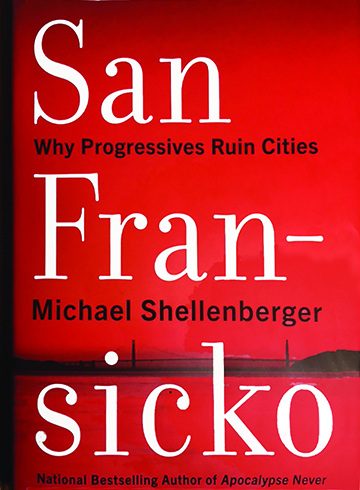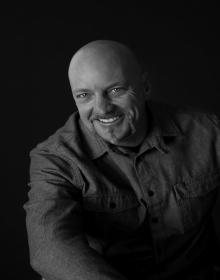“Progressives want livable, walkable cities, but by allowing the continued operation of open-air drug scenes, they are making cities unlivable and unwalkable, as well as inhumane.”
- Michael Shellenberger
In his recently published 350+ page opus, author Michael Shellenberger tackles the daunting task of unwrapping a multi-layered crisis which has reached a critical state in California’s City by the Bay.
For those who may be unaware, San Francisco, CA, is a city in the grips of a social, political, and humanitarian nightmare. Decriminalization of illicit drugs and mass adoption of progressive “harm reduction” policies have backfired, plunging the city into an epidemic of addiction. One resident, business owner Adam Mesnick, is quoted as saying, “What’s happening is not even liberal. It’s not realistic. It’s fantasy land. This is a severe drug addiction crisis that needs greater intervention or everyone’s just going to die from fentanyl.”
San Franshitsco
 Shellenberger describes how homelessness and rampant drug abuse are coupled with a statewide housing market that is grotesquely lopsided. This is apparent by the skyrocketing rental rates and property values which are pricing out many average citizens — even those with full-time jobs. The result is a populace with a large percentage of “unhoused” aka “homeless” people. In 2019, over 30,000 incidents of public defecation were reported in San Francisco, while California as a whole was found to account for 51% of all unhoused people in the entire United States.
Shellenberger describes how homelessness and rampant drug abuse are coupled with a statewide housing market that is grotesquely lopsided. This is apparent by the skyrocketing rental rates and property values which are pricing out many average citizens — even those with full-time jobs. The result is a populace with a large percentage of “unhoused” aka “homeless” people. In 2019, over 30,000 incidents of public defecation were reported in San Francisco, while California as a whole was found to account for 51% of all unhoused people in the entire United States.
Harm Induction
Shellenberger exposes “harm reduction” sites and so-called “Safe Sleeping Spaces” as the open-air drug scenes that they are. “Harm reduction” is a term used for government-approved areas which supply everything (equipment-wise) an addict needs in order to successfully inject narcotics such as methamphetamine, heroin, and fentanyl. NGO (non-governmental organization) workers provide addicts with tourniquets, cooking kits, syringes, and needles in an effort to somehow “reduce harm.” Shellenberger calls the practice what it truly is — “harm induction.” These NGOs are key drivers of the homeless epidemic, disguising a sadistic policy of aiding addiction behind the auspices of altruism.
Housing First
Shellenberger shines a harsh light on “housing first” which is the battle cry of many homeless advocates. This line of thinking advocates the reduction of access to overnight shelters and instead, insists on housing for addicts and mentally ill people without requiring sobriety, medication, and treatment. Shellenberger presents evidence that this policy does not effectively address the core issues which cause homelessness. To the contrary, by taking treatment for mental illness and drug addiction out of the equation — the issue spins further out of control.
A Huge Industry
Shellenberger goes to superhuman lengths to uncover, document, support, and reinforce the fact that homelessness and open-air drug scenes across the state are worsening in spite of the fact that taxpayer-funded spending on the issues is at an all-time high. The Homeless Industrial Complex, as absurd as it may sound, is very real and very much as counterintuitive and dysfunctional as the title suggests. While hundreds of millions of taxpayer funds are siphoned into this system, half of the money goes to staff salaries. It does not take a genius to realize that if they fix the problem, the cash cow is essentially taken from the milking parlor and put out to pasture.
A Legislative Nightmare
San Fransicko also presents a smorgasbord of political abominations which are adding fuel to the fire. Specifically, the decriminalization of the possession and use of illegal drugs is making it easier than ever for dealers to blatantly serve their market without fear of penalties. Meanwhile, deliberate reduction of the severity of crimes such as shoplifting, burglary, trespassing, and grand larceny has created a black-market industry which favors criminal behavior which is used to support addiction.
Crazy Town
Shellenberger further demonstrates how an unaddressed mental health epidemic is not only a miscarriage of the civil duties of elected government officials, but their pawning it off onto NGOs is downright irresponsible. The simple fact of the matter is that allowing those with untreated mental illness to openly and freely obtain and inject themselves with methamphetamines, fentanyl, and heroin is in no way a solution to a very serious problem.
A Viable Solution
Shellenberger goes on to suggest a comprehensive treatment solution for the mental health crisis via a plausible institution he dubs “Cal-Psych” which would “efficiently and humanely treat the seriously mentally ill and addicts, while providing housing to the homeless on a contingency-based system. Cal-Psych’s CEO would be best-in-class and report directly to the governor. It is only in this way that the voters could hold the governor accountable for the crises on the streets.”
Whether Shellenberger will be taken up on his offer to provide a plausible solution is anyone’s guess. Regardless, if homelessness, open-air drug scenes, rising crime, and increasing danger in your city concerns you, San Fransicko is required reading.
Image by article author
Michael Shellenberger exposes the flaws of a system gripped by addiction, psychosis and inhumane conditions.

